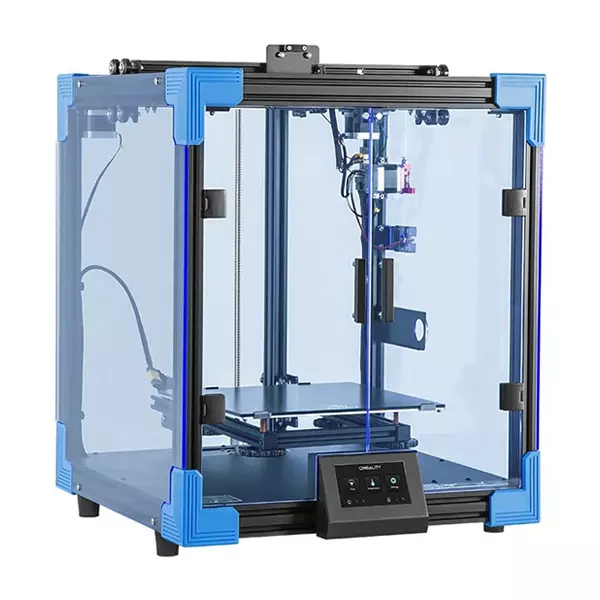Compare Ender 6 vs CR 10 Smart Pro
Comparison between the best 3D printers
Choose the best 3D printer at the best price. The cheapest 3D printers are here.
Buy a 3D printer here with 3D Fila.
 |
 |
|
| Model | Ender 6[BUY Ender 6] |
CR 10 Smart Pro[BUY CR 10 Smart Pro] |
| Printing Material | Filament | Filament |
| Buy Filament for Creality 3D Ender 6 | Buy Filament forCreality 3D CR 10 Smart Pro | |
| Estimated price | $499,00 | $900,00 |
| Manufacturer | Creality 3D | Creality 3D |
| Release Year | 2020 | 2020 |
| Print Volume [mm] | 250x250x400 | 300x300x400 |
| Printer Size [mm] | 495x495x650 | 578x522x648 |
| Weight [kg] | 22 | 13,6 |
| Power Loss Recovery | YES | YES |
| Enclosed printer | YES | NO |
| Bed Leveling | Manual | Manual |
| Filament End Sensor | YES | YES |
| Bed type | Heated | Heated |
| Power supply system | Bowden | Bowden |
| Standard nozzle | 0,4 | 0,4 |
| Maximum Nozzle Temperature [°C] | 260 | 300 |
| Maximum Bed Temperature [°C] | 100 | 100 |
| Maximum printing speed [mm/s] | 150 | 50 |
| Filament holder | YES | YES |
| Camera for supervision | NO | NO |
| Recommended filaments | PLA, TPU, ABS, PETG | PLA, PETG, Tritan, Flex, ABS |
| Recommended slicers | Cura, Simplify, Slic3r | Cura, Simplify, Slic3r, IdeaMaker |
| Maximum Resolution [mm] | 0,1 | 0,1 |
| Processor | 32 bits | |
| Display | Touchscreen TFT 4,3'' | Display touchscreen 4,3'' |
| Power Supply | 24V / 504W | 110/220V / 350W |
| Connectivity | SD / USB | SD / USB / Wi-Fi / Ethernet |
| Operating systems | Windows, Mac, Linux | Windows, Mac, Linux |
| Date of registration in the system | 2021-04-15 | 2022-11-04 |
| Release date | 2020 | 2020 |
| Extra features | The Creality Ender 6 stands out in the world of 3D printers with its CoreXY system, offering fast and high-quality prints. With a robust design, it has acrylic panels to protect against air currents, optimizing the printing of materials that require higher temperatures. It features a generic Creality hotend, effective up to ~240°C. Its differentials include 10mm GATES belts, promoting stability at high speeds, and a 360W power supply for reliable performance. The machine also has an intuitive user interface through a 4.3-inch touchscreen. | Creality's CR-10 Smart Pro printer offers a large 300x300x400mm build volume, Sprite Pro direct extruder for multiple materials, CR Touch auto-leveling, PEI magnetic bed, 4.3" touchscreen, LED lighting, and Creality Cloud connectivity. Some areas of improvement include the use of brass spindle nuts and tinned wires. |
| Support for multiple colors and materials (AMS and CFS) | NO | NO |
Notes * |
||
| Cost-benefit | 7 / 10 | 6 / 10 |
| Hardware | 2.5 / 10 | 2.5 / 10 |
| Tela | . | . |
| Print volume | 4 / 10 | 4 / 10 |
| Performance | 1 / 10 | 1 / 10 |
| [BUY Ender 6] | [BUY CR 10 Smart Pro] |
Conclusion |
| In comparing the Creality 3D Ender 6 and the CR-10 Smart Pro, both printers are released in the same year and are manufactured by the same company, but they cater to slightly different users and printing needs. The Ender 6 is positioned as a more budget-friendly option, offering an enclosed print area which can be beneficial for temperature-sensitive materials. Its higher maximum printing speed of 150 mm/s allows for quicker completion of prints, and features like manual bed leveling and a robust design contribute to a solid user experience for those willing to engage in hands-on adjustments. Its effective temperature limits and higher-quality construction, accentuated by features like the CoreXY system and 10mm GATES belts, establish it as a capable machine for enthusiasts and hobbyists. On the other hand, the CR-10 Smart Pro, while priced higher, boasts a larger print volume, increased nozzle temperature capacity, and comes equipped with assistive bed leveling. These features, paired with Creality’s cloud connectivity and direct extruder, make it better suited for users who may prioritize ease of use and versatility in material printing. However, its lower maximum printing speed and some noted areas for improvement in hardware may pose challenges to experienced users seeking a high-performance printer. Ultimately, the choice between the two printers hinges on user preferences; the Ender 6 stands out as the better value for users who prioritize speed and an enclosed build environment, while the CR-10 Smart Pro offers more advanced features for those willing to invest in a higher-performing and slightly more user-friendly machine. Thus, users should align their selection with their 3D printing goals, budget considerations, and desired feature set. |

